Stone tool
A stone tool is, in the most general sense, any tool made either partially or entirely out of stone. Although stone tool-dependent societies and cultures still exist today, most stone tools are associated with prehistoric (particularly Stone Age) cultures that have become extinct. Archaeologists often study such prehistoric societies, and refer to the study of stone tools as lithic analysis. Ethnoarchaeology has been a valuable research field in order to further the understanding and cultural implications of stone tool use and manufacture.[1]

| The Stone Age |
|---|
| ↑ before Homo (Pliocene) |
|
| ↓ Chalcolithic |
Stone has been used to make a wide variety of different tools throughout history, including arrow heads, spearpoints and querns. Stone tools may be made of either ground stone or chipped stone, and a person who creates tools out of the latter is known as a flintknapper.
Chipped stone tools are made from cryptocrystalline materials such as chert or flint, radiolarite, chalcedony, obsidian, basalt, and quartzite via a process known as lithic reduction. One simple form of reduction is to strike stone flakes from a nucleus (core) of material using a hammerstone or similar hard hammer fabricator. If the goal of the reduction strategy is to produce flakes, the remnant lithic core may be discarded once it has become too small to use. In some strategies, however, a flintknapper reduces the core to a rough unifacial or bifacial preform, which is further reduced using soft hammer flaking techniques or by pressure flaking the edges.
More complex forms of reduction include the production of highly standardized blades, which can then be fashioned into a variety of tools such as scrapers, knives, sickles and microliths. In general terms, chipped stone tools are nearly ubiquitous in all pre-metal-using societies because they are easily manufactured, the tool stone is usually plentiful, and they are easy to transport and sharpen.
Evolution
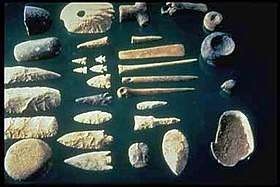
Archaeologists classify stone tools into industries (also known as complexes or technocomplexes[2]) that share distinctive technological or morphological characteristics.[3]
In 1969 in the 2nd edition of World Prehistory, Grahame Clark proposed an evolutionary progression of flint-knapping in which the "dominant lithic technologies" occurred in a fixed sequence from Mode 1 through Mode 5.[4] He assigned to them relative dates: Modes 1 and 2 to the Lower Palaeolithic, 3 to the Middle Palaeolithic, 4 to the Advanced and 5 to the Mesolithic. They were not to be conceived, however, as either universal—that is, they did not account for all lithic technology; or as synchronous—they were not in effect in different regions simultaneously. Mode 1, for example, was in use in Europe long after it had been replaced by Mode 2 in Africa.
Clark's scheme was adopted enthusiastically by the archaeological community. One of its advantages was the simplicity of terminology; for example, the Mode 1 / Mode 2 Transition. The transitions are currently of greatest interest. Consequently, in the literature the stone tools used in the period of the Palaeolithic are divided into four "modes", each of which designate a different form of complexity, and which in most cases followed a rough chronological order.
Pre-Mode I
- Kenya
Stone tools found from 2011 to 2014 at Lake Turkana in Kenya, are dated to be 3.3 million years old, and predate the genus Homo by about one million years.[5][6] The oldest known Homo fossil is about 2.4-2.3 million years old compared to the 3.3 million year old stone tools.[7] The stone tools may have been made by Australopithecus afarensis or Kenyanthropus platyops— (a 3.2 to 3.5-million-year-old Pliocene hominin fossil discovered in 1999) the species whose best fossil example is Lucy, which inhabited East Africa at the same time as the date of the oldest stone tools.[8][9][10][11][12] Dating of the tools was by dating volcanic ash layers in which the tools were found and dating the magnetic signature (pointing north or south due to reversal of the magnetic poles) of the rock at the site.[13]
- Ethiopia
Grooved, cut and fractured animal bone fossils, made by using stone tools, were found in Dikika, Ethiopia near (200 yards) the remains of Selam, a young Australopithecus afarensis girl who lived about 3.3 million years ago.[14]
Mode I: The Oldowan Industry
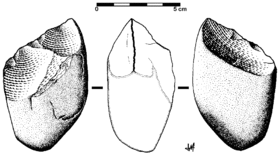
| Wikimedia Commons has media related to Oldowan. |
The earliest stone tools in the life span of the genus Homo are Mode 1 tools,[15] and come from what has been termed the Oldowan Industry, named after the type of site (many sites, actually) found in Olduvai Gorge, Tanzania, where they were discovered in large quantities. Oldowan tools were characterised by their simple construction, predominantly using core forms. These cores were river pebbles, or rocks similar to them, that had been struck by a spherical hammerstone to cause conchoidal fractures removing flakes from one surface, creating an edge and often a sharp tip. The blunt end is the proximal surface; the sharp, the distal. Oldowan is a percussion technology. Grasping the proximal surface, the hominid brought the distal surface down hard on an object he wished to detach or shatter, such as a bone or tuber.
The earliest known Oldowan tools yet found date from 2.6 million years ago, during the Lower Palaeolithic period, and have been uncovered at Gona in Ethiopia.[16] After this date, the Oldowan Industry subsequently spread throughout much of Africa, although archaeologists are currently unsure which Hominan species first developed them, with some speculating that it was Australopithecus garhi, and others believing that it was in fact Homo habilis.[17] Homo habilis was the hominin who used the tools for most of the Oldowan in Africa, but at about 1.9-1.8 million years ago Homo erectus inherited them. The Industry flourished in southern and eastern Africa between 2.6 and 1.7 million years ago, but was also spread out of Africa and into Eurasia by travelling bands of H. erectus, who took it as far east as Java by 1.8 million years ago and Northern China by 1.6 million years ago.
Mode II: The Acheulean Industry
_Amar_Merdeg%2C_Mehran%2C_Ilam%2C_Lower_Paleolithic%2C_National_Museum_of_Iran.jpg)
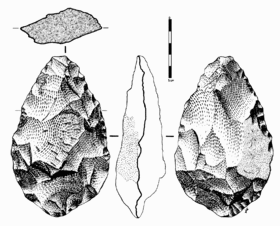
| Wikimedia Commons has media related to Acheulean. |
Eventually, more complex Mode 2 tools began to be developed through the Acheulean Industry, named after the site of Saint-Acheul in France. The Acheulean was characterised not by the core, but by the biface, the most notable form of which was the hand axe.[18] The Acheulean first appears in the archaeological record as early as 1.7 million years ago in the West Turkana area of Kenya and contemporaneously in southern Africa.
The Leakeys, excavators at Olduvai, defined a "Developed Oldowan" Period in which they believed they saw evidence of an overlap in Oldowan and Acheulean. In their species-specific view of the two industries, Oldowan equated to H. habilis and Acheulean to H. erectus. Developed Oldowan was assigned to habilis and Acheulean to erectus. Subsequent dates on H. erectus pushed the fossils back to well before Acheulean tools; that is, H. erectus must have initially used Mode 1. There was no reason to think, therefore, that Developed Oldowan had to be habilis; it could have been erectus. Opponents of the view divide Developed Oldowan between Oldowan and Acheulean. There is no question, however, that habilis and erectus coexisted, as habilis fossils are found as late as 1.4 million years ago. Meanwhile, African H. erectus developed Mode 2. In any case a wave of Mode 2 then spread across Eurasia, resulting in use of both there. H. erectus may not have been the only hominin to leave Africa; European fossils are sometimes associated with Homo ergaster, a contemporary of H. erectus in Africa.
In contrast to an Oldowan tool, which is the result of a fortuitous and probably ex tempore operation to obtain one sharp edge on a stone, an Acheulean tool is a planned result of a manufacturing process. The manufacturer begins with a blank, either a larger stone or a slab knocked off a larger rock. From this blank he or she removes large flakes, to be used as cores. Standing a core on edge on an anvil stone, he or she hits the exposed edge with centripetal blows of a hard hammer to roughly shape the implement. Then the piece must be worked over again, or retouched, with a soft hammer of wood or bone to produce a tool finely chipped all over consisting of two convex surfaces intersecting in a sharp edge. Such a tool is used for slicing; concussion would destroy the edge and cut the hand.
Some Mode 2 tools are disk-shaped, others ovoid, others leaf-shaped and pointed, and others elongated and pointed at the distal end, with a blunt surface at the proximal end, obviously used for drilling. Mode 2 tools are used for butchering; not being composite (having no haft) they are not very appropriate killing instruments. The killing must have been done some other way. Mode 2 tools are larger than Oldowan. The blank was ported to serve as an ongoing source of flakes until it was finally retouched as a finished tool itself. Edges were often sharpened by further retouching.
Mode III: The Mousterian Industry
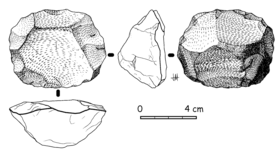
| Wikimedia Commons has media related to Mousterian. |
Eventually, the Acheulean in Europe was replaced by a lithic technology known as the Mousterian Industry, which was named after the site of Le Moustier in France, where examples were first uncovered in the 1860s. Evolving from the Acheulean, it adopted the Levallois technique to produce smaller and sharper knife-like tools as well as scrapers. Also known as the "prepared core technique," flakes are struck from worked cores and then subsequently retouched. [19] The Mousterian Industry was developed and used primarily by the Neanderthals, a native European and Middle Eastern hominin species, but a broadly similar industry is contemporaneously widespread in Africa. [20]
Mode IV: The Aurignacian Industry
The widespread use of long blades (rather than flakes) of the Upper Palaeolithic Mode 4 industries appeared during the Upper Palaeolithic between 50,000 and 10,000 years ago, although blades were still produced in small quantities much earlier by Neanderthals.[21] The Aurignacian culture seems to have been the first to rely largely on blades.[22] The use of blades exponentially increases the efficiency of core usage compared to the Levallois flake technique, which had a similar advantage over Acheulean technology which was worked from cores.
Mode V: The Microlithic Industries

.png)
Mode 5 stone tools involve the production of microliths, which were used in composite tools, mainly fastened to a shaft.[23] Examples include the Magdalenian culture. Such a technology makes much more efficient use of available materials like flint, although required greater skill in manufacturing the small flakes. Mounting sharp flint edges in a wood or bone handle is the key innovation in microliths, essentially because the handle gives the user protection against the flint and also improves leverage of the device.
Neolithic industries
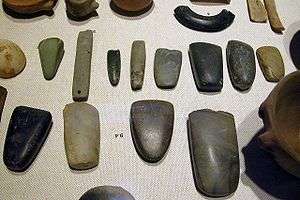
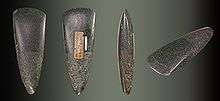

In prehistoric Japan, ground stone tools appear during the Japanese Paleolithic period, that lasted from around 40,000 BC to 14,000 BC.[24] Elsewhere, ground stone tools became important during the Neolithic period beginning about 10,000 BC. These ground or polished implements are manufactured from larger-grained materials such as basalt, jade and jadeite, greenstone and some forms of rhyolite which are not suitable for flaking. The greenstone industry was important in the English Lake District, and is known as the Langdale axe industry. Ground stone implements included adzes, celts, and axes, which were manufactured using a labour-intensive, time-consuming method of repeated grinding against an abrasive stone, often using water as a lubricant. Because of their coarse surfaces, some ground stone tools were used for grinding plant foods and were polished not just by intentional shaping, but also by use. Manos are hand stones used in conjunction with metates for grinding corn or grain. Polishing increased the intrinsic mechanical strength of the axe. Polished stone axes were important for the widespread clearance of woods and forest during the Neolithic period, when crop and livestock farming developed on a large scale. They are distributed very widely and were traded over great distances since the best rock types were often very local. They also became venerated objects, and were frequently buried in long barrows or round barrows with their former owners.
During the Neolithic period, large axes were made from flint nodules by chipping a rough shape, a so-called "rough-out". Such products were traded across a wide area. The rough-outs were then polished to give the surface a fine finish to create the axe head. Polishing not only increased the final strength of the product but also meant that the head could penetrate wood more easily.
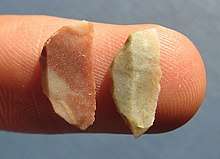
There were many sources of supply, including Grimes Graves in Suffolk, Cissbury in Sussex and Spiennes near Mons in Belgium to mention but a few. In Britain, there were numerous small quarries in downland areas where flint was removed for local use, for example.
Many other rocks were used to make axes from stones, including the Langdale axe industry as well as numerous other sites such as Penmaenmawr and Tievebulliagh in Co Antrim, Ulster. In Langdale, there many outcrops of the greenstone were exploited, and knapped where the stone was extracted. The sites exhibit piles of waste flakes, as well as rejected rough-outs. Polishing improved the mechanical strength of the tools, so increasing their life and effectiveness. Many other tools were developed using the same techniques. Such products were traded across the country and abroad.
Modern uses
The invention of the flintlock gun mechanism in the sixteenth century produced a demand for specially shaped gunflints.[25] The gunflint industry survived until the middle of the twentieth century in some places, including in the English town of Brandon.[26]
For specialist purposes glass knives are still made and used today, particularly for cutting thin sections for electron microscopy in a technique known as microtomy. Freshly cut blades are always used since the sharpness of the edge is very great. These knives are made from high-quality manufactured glass, however, not from natural raw materials such as chert or obsidian. Surgical knives made from obsidian are still used in some delicate surgeries.[27]
Tool stone
In archaeology, a tool stone is a type of stone that is used to manufacture stone tools. Alternatively, the term can be used to refer to stones used as the raw material for tools.
See also
|
|
References
- Sillitoe, Paul; Hardy, Karen (2 January 2015). "Living Lithics: ethnoarchaeology in Highland Papua New Guinea". Antiquity. 77 (297): 555–566. doi:10.1017/S0003598X00092619.
- Clarke, David (1978). Analytical Archaeology (2nd ed.). New York, NY: Columbia University Press. pp. 372–373. ISBN 0231046308.
- Kadowaki, Seiji (2013). "Issues of Chronological and Geographical Distributions of Middle and Upper Palaeolithic Cultural Variability in the Levant and Implications for the Learning Behavior of Neanderthals and Homo sapiens". Dynamics of Learning in Neanderthals and Modern Humans Volume 1. pp. 59–91. doi:10.1007/978-4-431-54511-8_4. ISBN 978-4-431-54510-1.
- Clarke, Grahame (1969). World Prehistory: a New Outline (2 ed.). Cambridge: Cambridge University Press. p. 31.
- Harmand, Sonia; Lewis, Jason E.; Feibel, Craig S.; Lepre, Christopher J.; Prat, Sandrine; Lenoble, Arnaud; Boës, Xavier; Quinn, Rhonda L.; Brenet, Michel; Arroyo, Adrian; Taylor, Nicholas; Clément, Sophie; Daver, Guillaume; Brugal, Jean-Philip; Leakey, Louise; Mortlock, Richard A.; Wright, James D.; Lokorodi, Sammy; Kirwa, Christopher; Kent, Dennis V.; Roche, Hélène (20 May 2015). "3.3-million-year-old stone tools from Lomekwi 3, West Turkana, Kenya". Nature. 521 (7552): 310–315. Bibcode:2015Natur.521..310H. doi:10.1038/nature14464. PMID 25993961.
- Foley, R. A.; Mirazón Lahr, M. (12 April 2011). "The evolution of the diversity of cultures". Philosophical Transactions of the Royal Society B: Biological Sciences. 366 (1567): 1080–1089. doi:10.1098/rstb.2010.0370. PMC 3049104. PMID 21357230.
- Morelle, Rebecca (20 May 2015). "Oldest stone tools pre-date earliest humans". BBC News. Retrieved 2016-01-03.
- Drake, Nadia (20 May 2015). "Wrong Turn Leads to Discovery of Oldest Stone Tools". National Geographic News.
- Harmand, Sonia; Lewis, Jason E.; Feibel, Craig S.; Lepre, Christopher J.; Prat, Sandrine; Lenoble, Arnaud; Boës, Xavier; Quinn, Rhonda L.; Brenet, Michel; Arroyo, Adrian; Taylor, Nicholas; Clément, Sophie; Daver, Guillaume; Brugal, Jean-Philip; Leakey, Louise; Mortlock, Richard A.; Wright, James D.; Lokorodi, Sammy; Kirwa, Christopher; Kent, Dennis V.; Roche, Hélène (20 May 2015). "3.3-million-year-old stone tools from Lomekwi 3, West Turkana, Kenya". Nature. 521 (7552): 310–315. Bibcode:2015Natur.521..310H. doi:10.1038/nature14464. PMID 25993961.
- Thompson, Helen (May 20, 2015). "The Oldest Stone Tools Yet Discovered Are Unearthed in Kenya". Smithsonian Magazine.
- Wilford, John Noble (20 May 2015). "Stone Tools From Kenya Are Oldest Yet Discovered". The New York Times.
- "Oldest Known Stone Tools Discovered: 3.3 Million Years Old". May 20, 2015.
- Zastrow, Mark (1 April 2016). "How a disparate team found the world's oldest stone tools". Nature Index.
- McPherron, Shannon P.; Alemseged, Zeresenay; Marean, Curtis W.; Wynn, Jonathan G.; Reed, Denné; Geraads, Denis; Bobe, René; Béarat, Hamdallah A. (August 2010). "Evidence for stone-tool-assisted consumption of animal tissues before 3.39 million years ago at Dikika, Ethiopia". Nature. 466 (7308): 857–860. Bibcode:2010Natur.466..857M. doi:10.1038/nature09248. PMID 20703305. Lay summary – ScienceDaily (August 11, 2010).
- Clarke's "chopper tools and flakes."
- Semaw, S.; M. J. Rogers; J. Quade; P. R. Renne; R. F. Butler; M. Domínguez-Rodrigo; D. Stout; W. S. Hart; T. Pickering; S. W. Simpson (2003). "2.6-Million-year-old stone tools and associated bones from OGS-6 and OGS-7, Gona, Afar, Ethiopia". Journal of Human Evolution. 45 (2): 169–177. doi:10.1016/S0047-2484(03)00093-9. PMID 14529651.
- Toth, Nicholas; Schick, Kathy (2005). "African Origins". In Scarre, Christopher (ed.). The Human Past: World Prehistory & the Development of Human Societies. Thames & Hudson. pp. 46–83. ISBN 978-0-500-28531-2. OCLC 1091012125.
- Clarke's "bifacially flaked hand axes."
- Clarke's "flake tools from prepared cores."
- Pettitt, Paul (2009), "The Rise of Modern Humans", in Scarre, Chris (ed.), The Human Past: World Prehistory and the Development of Human Societies (2nd ed.), London: Thames and Hudson, pp. 149–151
- Lewin, R.; Foley, R. A. (2004). Principles of Human Evolution (2 ed.). UK: Blackwell Science. p. 311. ISBN 0-632-04704-6.
- Clarke's "punch-struck blades with steep retouch."
- Clarke's "microlithic components of composite artifacts."
- "Prehistoric Japan, New perspectives on insular East Asia", Keiji Imamura, University of Hawaii Press, Honolulu, ISBN 0-8248-1853-9
- Flayderman, 1998
- Clarke, Rainbird (2 January 2015). "The Flint-Knapping Industry at Brandon". Antiquity. 9 (33): 38–56. doi:10.1017/S0003598X00009959.
- Harris, Kristen M. "Glass Knife Making".
External links
- Michaels, George H.; Fagan, Brian M. (1990–1998). "Principles of Lithic Technology". University of California. Retrieved 22 January 2011.
- Gunness, Jo Lynn (1998). "Lithic Technologies Notes". University of Hawaii Anthropology Department. Archived from the original on 13 June 2001. Retrieved 22 January 2011.
- Prindle, Tara (1994–2011). "Flaked Stone Tool Technology". Nativetech.org. Retrieved 22 January 2011.
- "Typology". Stone Age Reference Collection (SARC), University of Oslo. Archived from the original on 5 February 2006. Retrieved 22 January 2011.
- "Stone Tools of Texas Indians". Texas Beyond History, University of Texas at Austin. 2001. Retrieved 18 January 2011.
- Prindle, Tara (1994–2011). "Common Stone Types and Northeastern Lithic Technologies". Nativetech.org. Retrieved 18 January 2011.
- Grace, Roger. "Interpreting the Function of Stone Tools". Stone Age Reference Collection (SARC), University of Oslo. Archived from the original on 29 May 2010. Retrieved 18 January 2011.
- "How to recognize prehistoric stone tools". newarchaeology.com. Archived from the original on 6 September 2006. Retrieved 18 January 2011.
- "The World Museum of Man and Prehistory". World Museum of Man. 2004–2011. Retrieved 18 January 2011.
- English Heritage. "Globalising archaeology: producing tools in the Neolithic". Google Arts & Culture. Retrieved 19 August 2018.